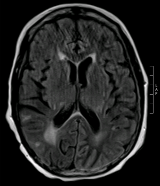SMART Syndrome as an Unusual Presentation of Convulsive Status Epilepticus
Abstract number :
2.128
Submission category :
4. Clinical Epilepsy / 4B. Clinical Diagnosis
Year :
2018
Submission ID :
502417
Source :
www.aesnet.org
Presentation date :
12/2/2018 4:04:48 PM
Published date :
Nov 5, 2018, 18:00 PM
Authors :
Miguel Melo-Bicchi, University of Maryland Medical Center; Ahmareen Baten, University of Maryland Medical Center; and Jennifer Pritchard, University of Maryland Medical Center
Rationale: SMART syndrome (Stroke-like Migraine Attacks after Radiation Therapy) is a rare and underrecognized delayed complication of brain radiation therapy. The neurological symptoms include migraine-like symptoms and may be accompanied by other neurological deficits including confusion, seizures, hemiparesis, hemisensory changes, and aphasia. Status epilepticus is a rare presentation of SMART syndrome. Methods: Case report of a patient with SMART syndrome with an unusual presentation of convulsive status epilepticus. Results: This is a 50-year-old woman right-handed woman with history of migraines, hypertension and lung cancer status post left upper lung lobectomy with metastasis to the spine and brain status post whole brain radiation therapy and right parieto-occipital metastasis resection and chemotherapy in remission for 11 years. She was admitted to the hospital due to a 5-day history of seizures, global aphasia and right-sided weakness. Upon admission she was still seizing with multiple episodes of right head version, right gaze deviation, right arm extension and left arm flexion (fencing posturing) followed by right hemibody shaking. Antiepileptic therapy was escalated, and she was monitored on CEEG.The aforementioned seizures were captured on CEEG and she was found to be in convulsive status epilepticus. Her EEG showed evolving left posterior quadrant rhythmic delta activity spreading to the left frontal/central region with spread across the left hemisphere and sometimes generalized. She underwent extensive workup including lumbar puncture and infectious, paraneoplastic and autoimmune laboratories which were unremarkable.MRI brain with and without contrast revealed abnormal cortical thickening and increased FLAIR signal in the left parietal, temporal and occipital lobes; scattered microhemorrhages in the hemispheres and increased vascular enhancement in the left parieto-occipital region. There was also a new punctate cortical enhancement in the left frontal lobe, not seen in prior MRIs. These findings are most likely attributed to radiation and seizure-related edema and are described in SMART syndrome. Her status epilepticus was most likely due to SMART syndrome. Conclusions: SMART syndrome is a rare late complication of cranial radiotherapy in which seizures and rarely status epilepticus can be observed together with focal neurologic deficits. In our case the patient was diagnosed with SMART syndrome through her presentation with convulsive status epilepticus and her characteristic MRI findings, and prior history of brain irradiation years ago and migraines. This syndrome may be confused with tumor progression and lead to antineoplastic treatment that could deteriorate the patient’s clinical status. Hence, clinicians should be aware of this disorder to better treat such patients. Funding: Not applicable

.tmb-.png?Culture=en&sfvrsn=1b406d37_0)